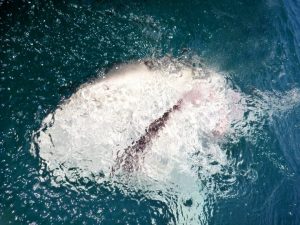“Interstate Love Song”
Sunday, April 3rd 2011
One of our sampling sites, the outer reef site, represents a southerly migratory route for larger coastal and semi-pelagic Atlantic sharks, as it is so close to the Gulf Stream. In fact, our most recent trip out to the deep reef yielded a variety of unique, larger shark species, providing some evidence that various coastal sharks may use this region as an oceanic interstate highway. Many thanks to the Stone Temple Pilots for their inspiration on this blog’s title named after their very own “Interstate Love Song,” due to the oceanic-highway-like region we sampled on April 3, 2011.
The last few trips for RJD had been a bit slow in terms of shark presence, and the team was definitely primed for some more action. A nice sunny day out on the reef would provide that very spark that reminds us why we are working to raise awareness and promote the conservation of threatened marine ecosystems.
After dropping our first set of drumlines, we noticed that there was a ripping subsurface current—bad for keeping track of our floating gear, but great for bringing sharks into our slick and baits. Waiting on the bridge, we noticed that we were sitting right in the middle of two colors of water—green and blue. While I am no oceanographer, I can say with some confidence that we were hanging right on the edge of a convergence zone in the gulf stream—an area where waters of difference temperatures and nutrients “mix.” These areas usually teem with plankton, which in turn brings in plankton-eating fish, attracting fish that eat other fish, truly a place to see the food web in action. We hoped that today we would see the very species that controls that same food web.
Our first visitor was a sandbar shark, a rather large species, which uses both coastal and offshore habitats for feeding and nursing. Sandbar sharks are present in much of the entire US eastern seaboard, yet they are only “spring breakers” for us here in Southern Florida. They usually stick around in the Keys from April to June, and then move off. We were also lucky to bring in a large male great hammerhead. We worked on him alongside the boat and set him back to the Gulf Stream in 2 minutes. He was about 12 feet—the largest male great hammerhead I have seen in a long time! Hopefully he is currently “courting” various females and passing on the torch…its not easy being a great hammerhead in today’s risky waters.

The cephalofoil (the hammer) of a scalloped hammerhead: note the extra curvature on the ends. Click to enlarge.
We were also very lucky to get three sub-adult scalloped hammerheads, which are usually quite rare in the subtropical waters we survey. Nevertheless, they must have come in from with the Gulf Stream, as they were likely chasing mahi and other bony fish. This species of hammerhead is generally much smaller than great hammerheads, with a less-pronounced dorsal fin and a more curved hammer (jargony word of the day: cephalofoil). In fact, one scalloped hammerhead was so strong that Captain Curt dropped down his shades to his nose and proclaimed “Wow, that’s a strong shark, Austin.” More importantly, Curt and I were able to attain access to the caudal vein of these scalloped hammerheads, allowing us to get those much-needed blood samples for our stress physiology work.
The day also brought in a massive bull shark—a species which usually has a tighter connection to in-shore habitats. The water mixing and upwelling surely brought him out into the reef as well. He was being tailed by three huge cobia, a type of game fish that may follow for scraps and protection, their presence suggesting that the shark we were about to survey was an effective and healthy predator. All sharks were sampled and released back into the productive waters of the outer reef in great condition. Today the Gulf Stream acted as an interstate highway for large sharks, sharks that we are intrigued and fascinated by, worthy of their own “Interstate Love Song.”

A scalloped hammerhead just prior to release back into the Interstate, sporting a RJD fin tag. Click to enlarge.
-Austin Gallagher


Beautiful pictures like always!